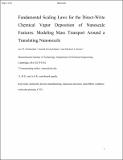| dc.contributor.author | Drahushuk, Lee W. | |
| dc.contributor.author | Govind Rajan, Ananth | |
| dc.contributor.author | Strano, Michael S. | |
| dc.date.accessioned | 2022-03-23T14:57:07Z | |
| dc.date.available | 2021-10-27T20:29:48Z | |
| dc.date.available | 2022-03-23T14:57:07Z | |
| dc.date.issued | 2019-01 | |
| dc.date.submitted | 2018-12 | |
| dc.identifier.issn | 2040-3364 | |
| dc.identifier.issn | 2040-3372 | |
| dc.identifier.uri | https://hdl.handle.net/1721.1/135884.2 | |
| dc.description.abstract | © 2019 The Royal Society of Chemistry. The nanometer placement of nanomaterials, such as nanoribbons and nanotubes, at a specific pitch and orientation on a surface, remains an unsolved fundamental problem in nanotechnology. In this work, we introduce and analyze the concept of a direct-write chemical vapor deposition (CVD) system that enables the in-place synthesis of such structures with control over orientation and characteristic features. A nanometer scale pore or conduit, called the nanonozzle, delivers precursor gases for CVD locally on a substrate, with spatial translation of either the nozzle or the substrate to enable a novel direct write (DW) tool. We analyze the nozzle under conditions where it delivers reactants to a substrate while translating at a constant velocity over the surface at a fixed reaction temperature. We formulate and solve a multi-phase three-dimensional reaction and diffusion model of the direct-write operation, and evaluate specific analytically-solvable limits to determine the allowable operating conditions, including pore dimensions, reactant flow rates, and nozzle translation speed. A Buckingham Π analysis identifies six dimensionless quantities crucial for the design and operation of the direct-write synthesis process. Importantly, we derive and validate what we call the ribbon extension inequality that brackets the allowable nozzle velocity relative to the CVD growth rate-a key constraint to enabling direct-write operation. Lastly, we include a practical analysis using attainable values towards the experimental design of such a system, building the nozzle around a commercially available near-field scanning optical microscopy (NSOM) tip as a feasible example. | en_US |
| dc.language.iso | en | |
| dc.publisher | Royal Society of Chemistry (RSC) | en_US |
| dc.relation.isversionof | http://dx.doi.org/10.1039/c8nr10366f | en_US |
| dc.rights | Creative Commons Attribution-Noncommercial-Share Alike | en_US |
| dc.rights.uri | http://creativecommons.org/licenses/by-nc-sa/4.0/ | en_US |
| dc.source | Royal Society of Chemistry (RSC) | en_US |
| dc.title | Fundamental scaling laws for the direct-write chemical vapor deposition of nanoscale features: modeling mass transport around a translating nanonozzle | en_US |
| dc.type | Article | en_US |
| dc.contributor.department | Massachusetts Institute of Technology. Department of Chemical Engineering | |
| dc.relation.journal | Nanoscale | en_US |
| dc.eprint.version | Author's final manuscript | en_US |
| dc.type.uri | http://purl.org/eprint/type/JournalArticle | en_US |
| eprint.status | http://purl.org/eprint/status/PeerReviewed | en_US |
| dc.date.updated | 2021-06-15T12:28:01Z | |
| dspace.orderedauthors | Drahushuk, LW; Govind Rajan, A; Strano, MS | en_US |
| dspace.date.submission | 2021-06-15T12:28:03Z | |
| mit.journal.volume | 11 | en_US |
| mit.journal.issue | 6 | en_US |
| mit.license | OPEN_ACCESS_POLICY | |
| mit.metadata.status | Authority Work Needed | en_US |
